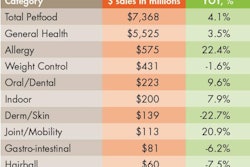At the
recent Joint Annual Meeting of the American Society of Animal Science and
American Dairy Science Association and Canadian Society of Animal Science there
were 27 topical reviews and original research presentations focused specifically
on companion animals out of the hundreds of abstracts in the program. The
conference was held at the Kansas City Convention Center on July 20–24, 2014,
and was well attended by an array of “pet-centric” students, faculty and
industry researchers from around the globe. Two symposia pertaining to
companion animals merit special note.
The first was a session focused specifically on sustainability
and companion animals with a view toward today's impact on the future. Each of
the presentations worked from a similar platform or definition of
sustainability introduced by the first speaker, Dr. Becky Carter. To paraphrase,
sustainability in the food system is “the ability to provide sufficient
calories and essential nutrients for today's requirements without compromising
the supply for future generations.” Carter and her co-authors from the Nutro Company
and the University of Illinois equated sustainability in the petfood system
with that of responsible pet ownership. They stated that “it requires a careful
balance with consumer expectations.”
From a raw
material perspective, Dr. David Meeker with the Fats & Protein Research
Foundation followed with an overview of how the rendering industry fits into
this equation. He explained that it contributes to sustainability by capturing
materials from the meat industry that would otherwise go to waste without their
intervention. From this presentation emerged the question of whether the petfood
industry might actually yield "credits" to the human food system and benefit
sustainability through the value-return afforded by the rendering industry, a
true interdependency often overlooked.
Dr. Gordon
Ballam of Purina Animal Nutrition (Land O’Lakes) provided an interesting
perspective on “companion animals” that we often consider as livestock, animals
such as chickens, alpaca and sheep, among others. By his premise, "back-yard
flocks" take on a companion animal status and represent a decentralized or
non-concentrated form of “personal” animal rearing. With proper education and
management this approach may place a lower pressure on the environment and
thereby improve overall sustainability of food production—an interesting twist
to the idea of a pet.
At the other
end of the spectrum, Dr. Susana (Beth) Kitts-Morgan presented fascinating work
from her program at Berry College in Mount Berry, Georgia, that tracks the
impact on indigenous species from predation by feral and domestic free-ranging
cats. Her work corroborates other recent papers that suggest the “cat on the
prowl” can have a devastating impact on native bird populations. Additionally,
they found that supplemental food availability didn’t necessarily curb the cat’s
desire to hunt and kill. Methods to lessen the impact from free-ranging cats were
discussed, but the situation is something that defies an easy solution without significantly
more exploration.
To bring the
session to a close, Dr. Kelly Swanson from the University of Illinois provided
an overview of future research needs, potential approaches to evaluate sustainability
and how to capture the concept in measurable terms. He suggested that
“considerations of carbon or water ‘footprint’ due to petfoods, rather than
extrapolation from a human foods perspective, is needed to fully grasp how
companion animals impact food sustainability for future generations.” Much more
needs to be done in this area. Without some form of institutional support it
will be necessary to add this type of information gathering on top of other
fundamental research questions so that a wider analysis might be performed in
the future and consequently leverage ongoing projects.
The second symposium regarding companion animals
pertained to training the next generation of companion animal biologists. This
was part of the first "George C. Fahey Companion Animal Nutrition Symposium."
Dr. John McNamara from Washington State University opened with an overview of
how he personally evolved from a focus on dairy nutrition to teaching companion
animal biology in lock-step with the evolution of traditional animal science
departments. While he emphasized instruction in the fundamentals of animal
biology, he acknowledged the need to adapt to the changing demographic of
students and apply lessons to the species they find most interesting.
Dr. Lisa
Karr-Lilienthal provided an overview of her program at the University of
Nebraska-Lincoln and the activities she has found successful for reaching this
generation of Millennials. In short, she provided compelling examples of how
social media and technology can be effectively deployed in and out of the
classroom to gain their attention. Case in point, she shared that today's
students don’t respond to email. This next generation of consumers is bright
and has a passion for learning, but shifting communication technology is second
nature. To reach them requires nimble adaptation to the latest technologies, a
lesson for marketing … regardless of whether it’s knowledge at a university or
products on the store shelf.
Dr. Kate
Shoveller from P&G Pet Care (now Mars) provided an overview of how to adapt
through the changes that are common in any industry, but also emphasized that
many of the key skills necessary to successfully navigate through a new job—academic
or corporate— requires a great deal of skills we don't necessarily teach in
college. Aside from all of the hard skills obtained during a formal education,
it’s the soft skills like interpersonal relationships, problem-solving,
collaboration and interaction amongst disciplines and business processes that
measure one’s success.
To bring
this symposium to a close, Dr. Marianne Swaney-Stueve and Dr. Greg Aldrich
presented an overview (on behalf of Dr. Kadri Koppel who was unable to attend) regarding
an approach being utilized at the Sensory Analysis Center at Kansas State University
for integrating trained human taste panels and consumer research with petfood
analysis and where this communication interface connects research, teaching and
consumers. They shared where this approach provides additional dimensions to
taste, flavor, aroma and product evaluation when integrated with chemical
analysis, consumer purchasing decisions and animal responses.
The
implication is that use of humans to evaluate petfoods may help to better
construct new products and monitor quality and consistency. Students with an
interest in a broader array of sciences that transcends animal and human
behavior, sensory science and analytical chemistry will be needed. Certainly a
whole new generation of tech-savvy students and workers are going to be in
demand and they need a special mix of fundamental knowledge, coupled with
nimble social skills, and an ability to work across a wider array of
disciplines as we continue to redefine how pets are further integrated into
homes and communities.
In all there were another 18 original research papers
presented in oral and poster formats that covered some very interesting topics,
including animal gait analysis, use of GPS to track predation ranges, bioenergetics,
processing impact on vitamins, nutrient availability of different processed ingredients
such as corn, beans and gelatin, and nutrigenomics relative to young and old
dogs. Each of these papers, we hope, will appear in full publication in various
peer-reviewed scientific journals in the very near future. In the meantime, the
reader is encouraged to access the meeting information online if they’d like
more details than the space here allows (www.asas.org/meetings/jam2014/home).
The quantity
and quality of the work presented at this conference and others this summer has
been encouraging. What was presented at this meeting of Animal Scientists is a
solid demonstration that while scant funding is provided by federal and state
agencies to this segment of our animal population, solid industry-academic
partnerships are contributing in ways that are meaningful and timely.
Stay
up-to-date on industry ingredient issues:
Read more columns by Dr. Aldrich at www.petfoodindustry.com/ingredientissues.aspx.


















